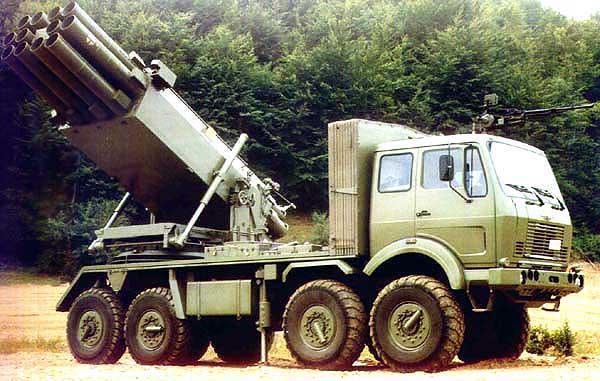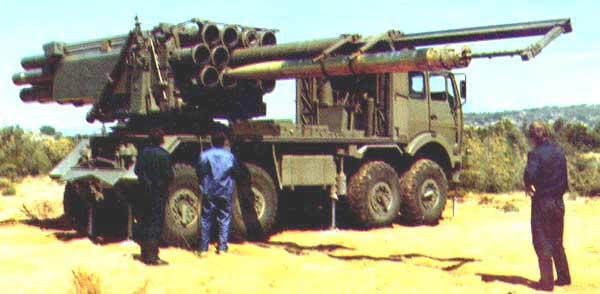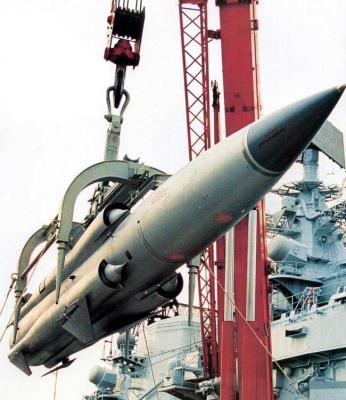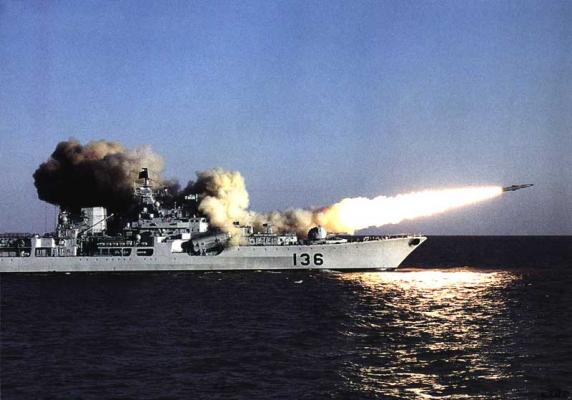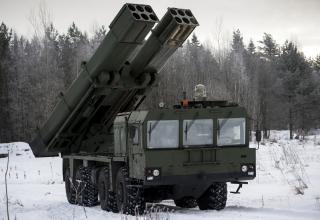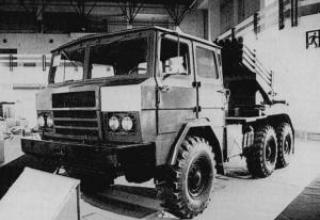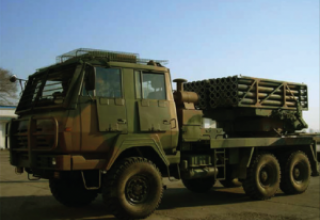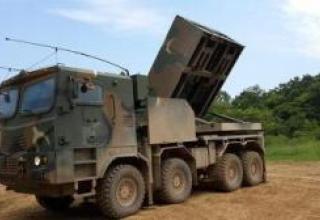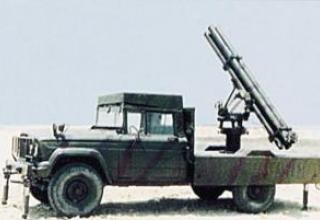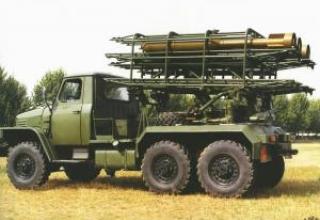The M87 "Orkan" multiple rocket launcher system is designed to engage the enemy's manpower, lightly armored and armored vehicles at concentration sites and on the march, destroy command posts, communication centers and military industrial infrastructure, remotely install anti-tank minefields in the combat zone at a distance of up to 50 km...
The system was developed by the Yugoslav Military and Technical Institute as part of a joint Yugoslav-Iraqi project. Unguided rockets were manufactured at the "UNIS-PRETIS" plant (Sarajevo), the combat vehicle - at the "Brotherhood" plant (Travnik). Tests of M87 "Orkan" MRLS were completed in 1985 and the system was adopted by the Yugoslav People's Army (UAE). The developers managed to create a rather successful system, which was notable for its combat efficiency, high degree of automation and operational reliability in various climatic conditions. It was reported about the development of a 262-mm caliber jet projectile with an extended range of up to 70 km.
Modernized versions of the M87 "Orkan" MLRS are in service with the Iraqi Army (under the designation of "Ababeel-50"), Bosnia and Croatia (under the designation of "Tajfun"). During 1994 and 1995, a small number of these systems were deployed during the conflicts in the Balkans.
One variant of the system, designated M-93 "Orkan-2" (see photo), was a package of 4 tracks placed on the chassis of the Luna-M rocket system.
Composition:
M87 "Orkan" includes:
- LRSV-262 M87 "Orkan" combat vehicle;
- unguided 262mm rockets (NURS);
- fire control system;
- Transport and Charging Vehicle (TZM) at 24 NURS;
Fighting vehicle (BM) LRSV-262 M87 "Orkan" is placed on a modified chassis of off-road truck FAP 3232 BDS/A with the wheel configuration 8x8. The artillery part includes a package of 12 tubular rails, swivel base with guidance mechanisms and sighting devices, as well as electrical and hydraulic equipment. Guidance mechanisms equipped with power drives make it possible to point the guide package in the vertical plane from -0.5° (+22° when firing forward) to the maximum elevation angle of +56°. Horizontal pointing angle ± 110° from the longitudinal axis of the machine. Guidance - automatic by fire control system commands, semi-automatic or manual. To increase the stability of the combat vehicle during firing and its horizon, four supports with hydraulic jacks are mounted in the aft and central part of the chassis. Horizon mechanism provides compensation of ±5° of unprepared firing position.
With its own weight of 15t and weight in the outfitted state of 32t the LRSV-262 BM has rather high cross-country ability characteristics: the depth of the ditch to be overcome is 1.8m, the depth of the ditch to be overcome is 25%, the depth of the ditch to be overcome is 60%, and the ford depth is 1.2m. The power of the diesel engine is 235 kW. The combat vehicle is equipped with a centralized tire pressure control system, which is operated from the driver's cab. On the march BM disguises itself as an ordinary truck. The roof of the combat vehicle cab is equipped with a 12.7 mm anti-aircraft machine gun. The calculation consists of five numbers and is located in an air-conditioned cabin. The fire is controlled from the vehicle cab or by remote control via a 20 or 50 m long cable. The LM is equipped with a navigation system. The temperature range of operation is from -30°С to +54°С.
Charging of the combat vehicle is carried out with the help of a special device mounted on rails and connected to the hydraulic system of the BM.
Unguided rockets of 262 mm caliber and 4656 mm length are used for firing. NURS is equipped with a dual-mode rocket motor. The maximum projectile flight speed is 1200 m/s, the flight time for the maximum range of 50km is 110s. NURS stabilization is provided by stabilizers in the tail part of the projectile, installed at an angle to the longitudinal axis of the projectile and providing its rotation in flight. When using different aerodynamic brakes the following flight ranges can be achieved: 24, 28, 37 and 50 km. Probable dispersion at maximum range is 220m in range and 175m in direction. The battery volley area of the four combat vehicles is 3-4 km2. The missiles are transported and stored in sealed containers made of fibreglass reinforced polyester; they can be stored outdoors.
Several types of head units (HUs) have been developed:
- Shrapnel-flash, equipped with a shock fuse of inertial type of instant or delayed action, weighing 91 kg. The weight of the NURS is 389 kg;
- cassette cluster, equipped with 288 KB-2 fragmentation warheads, designed to engage openly located manpower, light armoured combat vehicles and other military equipment. The head unit is equipped with an electronic fuse that ensures destruction of the hull of the MS at the end of the trajectory and breeding of combat elements. The caliber of the KB-2 combat element is 40 mm and its armor penetration is up to 60 mm. An explosion of a warhead produces fragments of up to 420 pieces with a radius of lesion exceeding 10 metres. The weight of the NURS with a cassette warhead is 389.7 kg, maximum projectile range is 50 km, dispersion area is 20000 square meters.
- The cluster munition with KPOM anti-tank mines (YU-S-AT) is designed for remote installation of minefields in front of enemy's military equipment units located at the edge of the attack and in the areas of concentration. The MS with a total weight of 83 kg is equipped with 24 mines placed in 8 containers. The mass of the mine is 1.8kg, calibre 105mm and the weight of the explosive charge is 0.4kg. When detonated, the mine can penetrate more than 40 mm of armour. The mine detonator is a non-contact magnetic action. Self-liquidation time - 24 hours. Weight of the projectile is 382.2 kg.
The M-87 battery includes: four LRSV-262 combat vehicles, four TZM, a command and staff vehicle, two landmarks and a meteorological complex, as well as two observation points on the chassis of 4*4 light vehicles.
Characteristics:
| Range of fire, km | 5-50 |
| NURS caliber, mm | 262 |
| NURS Length,mm | 4656 |
| Fighting vehicle LRSV-262 M87 "Orkan" | |
| Number of guides | 12 |
| Battle weight, t | 32 |
| Dimensions: - length, m - width, m - height, m |
9.000 2.640 3.840 |
| Maximum travel speed, km/h | 80 |
| Average speed on highways, km/h. | 55 |
| Power reserve, km | 600 |
| Battle station time, mines | 2 |
| Camping time, min. | 1 |
| Calculation, man. | 5 |
Testing:
Tests of "Moskit" complex started in June 1978 at "Sandy Beam" range. The flight and design tests began with two throw launches on June 9 and October 10, 1978. The mock-up of the rocket was equipped only with the starting engine. Both launches were normal. Then came a long break, mainly due to the unpreparedness of the material part of the rocket, in particular, the marching engine, which was difficult to be brought to the manufacturer.
On December 29, 1979 a model equipped with a marching engine was launched. The launch was unsuccessful, as the marching engine was not launched, and the starter remained in the nozzle block of the marching engine after development. After the start, a timeout was taken again to rework the marshal engine. The next launch took place only on July 3, 1980. The task of the launch was to get a reliable start of the rocket and make a flight at an altitude of about 20m. The launch was considered to be successful, but the marching engine never reached the design mode.
January 27, 1981 the rocket "Moskit" for the first time was launched in full configuration, but without turning on the active channel combined CNS. The rocket was to hit the target SM Pr.1784 at a distance of 38 km. The launch was unsuccessful due to instability of the onboard control system. At launch on April 28, 1981 a task similar to the previous launch was set. Direct hit to the target was achieved. On June 2 there was shooting at two targets - SM pr. On June 2 there was firing at two targets - SM Pr. 1784 and BKShP No. 436 bis at the distance of 38 km without switching on the active channel of combined GSN. The launch was successful and a direct hit to a larger target, SM, 1784 Pr. was achieved.
By the beginning of June 1981 a new modernized target SM Pr.1784 arrived to provide flight tests of ZM-80 missiles. 1784M Prospect, manufactured in Nikolaev. On this target, as well as on the old SM Ave. The whole system of radar reflectors in the amount of about 50 pieces of different types (K-0.7, K-1.25, etc.) and a thermal imitator "Balancer" working on household gas propane-butane were left on this target, only instead of one burner there were two (it was believed that a big ship - a battleship, a cruiser or an aircraft carrier - had at least two radiation centers). The target of the CM Ave. At the SM target of 1784M Ave. the system of external trajectory measurements was fundamentally improved. Previously, the film camera and photo equipment, shooting the missile approach to the target, were installed "on the eye", and now the film camera was tied to the target itself with a high degree of accuracy. The camera viewing angles were chosen so that they necessarily included some element of the target structure in addition to the missile. In order to test the operation of the active channel of the combined RS on a ZM-80 missile on the SM target, the cameras were designed to be able to detect the target. 1784M was equipped with a special system called "Minaret". The system included "Don" radar with a modified antenna system, remote control system for television signaling and telecommunications, equipment for documentation of operating modes, etc. In addition, two "Puck" and "Rynda" systems were installed, which determined the missile miss rate. The "Puck" system determined the magnitude of the miss relative to its antenna, and the "Rynda" system determined the magnitude of the miss relative to the so-called "reduced target". The target also had a well-equipped cockpit to accommodate the team. On June 26, 1981, two targets were fired - SM Pr.1784M, set from the starting point at a distance of 40 km, and on the BKShchina Pr.436 bis, set from the starting point at a distance of 10 km. The missiles were launched with active and passive CNS channels connected. The launch was considered successful. The missile hit the SM target at 436bis Ave. 1784M (pierced the target grid at 1.0m from the deck) and was driven 80km from the launch point. This launch ended the program of flight and design testing of the Moskit complex.
Launches under the program of joint (state) testing began in August 1981. At this stage of testing, the missiles were launched both from the coastal launcher and from a large missile boat of project 1241.1 (plant № 402) and destroyers of project 956 "Modern" (plant № 861) and "Desperate" (plant № 862). The first launch under the joint testing program took place on August 21 from the coastal launcher on target SM of 1784M pr.1784M to the range of 102 km. The task of the launch was to check the operation of all units and assemblies. Direct hit to the target was achieved. On September 30 it was launched from the boat of project 1241.1. The model of the rocket was equipped only with a starting engine. The mock-up was launched normally from the boat, which ran at a speed of 24 knots. when the sea waves 2-3 points. After that, the boat with the factory number. 402 was allowed to participate in joint testing of the Moskit complex.
On October 2, 1981 the launch was made with the task similar to the launch on August 21, but this time the target was not exposed. The launch was considered successful.
On November 24th the boat of project 1241.1 was launched from the target of SM Pr. On November 24th it was launched from the boat of the project 1241.1 on the SM target of 1784M pr. for the range of 100 km. The launch ended in failure due to a malfunction in the onboard control system. The rocket fell into the sea on the 10th second after the launch.
On December 27, 205 and 305 missiles were fired in volley from the boat of 1241.1 Ave. at two targets - BKShchinskaya Ave. 436 bis and SM pr. 1784М. The distance to the target of the BKSh was 10 km. Missile No 205 was aimed at this target. The launch was considered successful - a direct hit to the target was achieved. The range to the SM target was 33km. Missile No. 305 was to be aimed at this target. The launch was unsuccessful - the covers of the air intakes of the marching engine did not open, and the missile was brought to 23.7 seconds of flight. The interval between launches was 5 seconds.
On April 14, 1982 the missile was launched from the shore-based installation on the target of the SM Ave. 1784M Ave. at a distance of 100 km. The launch was unsuccessful. The missile fell at the 24th km distance due to malfunctions in the onboard control system.
On April 29, the first launch from the destroyer of the project 956 "Modern" in the Northern Fleet on the target of OS-111 (trawler project 265K) at a distance of 141 km was made. The launch was successful - a direct hit to the target superstructure was achieved. May 26, 1982 volley firing of rockets № 106 and № 505 from the destroyer "Modern" on the target of OS-111 at a distance of 35.5 4 m was carried out. Both missiles with equipment for the combat unit TC-22 were simultaneously launched from both sides of the destroyer. Rocket number 505 hit the target, hitting its superstructure. Rocket number 106 did not lower the flight height in front of the target, flew over it at an altitude of 17 m from the waterline and flew 47.5 km. The shooting was found to be partially successful. But the rocket number 106 could have flown not 17 m above the waterline, but 170 m, still with the presence of TC-22 ship would not have seemed a little Yankee.
On August 31, 1982, it was launched from the boat of project 1241.1 at a distance of 100 km with a 50-target position after the launch from two targets of OS-111 and SM pr. 1784М. The launch was unsuccessful - the marching engine was not launched and the missile fell into the sea at a distance of 12.8 km from the boat.
September 15 was a repeat of the previous launch. On September 15, it was a repeat of the previous launch. 1784M Ave. and hit it. The actual range of fire was 107.7 km.
On September 29 the boat of project 1241.1 was launched from the boat to the range of 27 km at the target of OS-1.11. A direct hit was achieved, the target sank.
November 28, volley firing of rockets ¹ 306 and ¹ 506 was made from the destroyer of project 956 "Desperate" in the Barents Sea in the Northern Fleet. (Shots were fired in parallel with the ship's delivery tests.) The target range of the target was set at the SM Ave. 1784 was 27 km. The speed of the ship during the launch was 20 knots. Firing was carried out from the starboard launcher, the interval between launches was 5 seconds. The target was hit by both missiles.
This was the end of the joint testing of the Moskit complex. In the course of these tests conducted 15 launches (14 missiles and 1 mock missile). According to the decision of the State Testing Commission, there were 8 fully successful launches, 5 partially successful launches and 2 unsuccessful ones.
In the period from 1983 to 1988, there were three types of tests of the Moskit complex. Firstly, tests on improvement of tactical and technical characteristics, ZM-80 missiles were conducted. In total, there were three launches: March 11, 1983, June 29, 1983. (mock missile) and December 7, 1984. At this stage, the flight range of 125 km was achieved.
Since the early 1980s, the possibility of installing the Moskit complex on the Lunar screen of Project 963 was considered. For this purpose, a mock-up of the screen plan of project 903 was installed at the "Sandy Beam" range in the village of Chernomorsk. The main purpose of the tests was to check the ability of the screen plan design to withstand the force and heat of the starting engine jet. On October 5 and December 21, 1984 two launches of "Moskita" mock-ups equipped only with starting engines were held. The first launch was made from the right container of the bow pair of launchers, and the second launch - from the left container of the tail pair of launchers. Since there were only two containers, the nose pair stood in its place at the first start and then it was moved to the tail. During these tests were tested two options for loading missiles on the screen, the first version of the rocket was loaded into a container already installed on the screen, using the loading device, the second version of the rocket was loaded into a container located on the ground, and then the entire structure was installed on the screen. All launches went smoothly. After the first launch 9 tiles were damaged, after the second one - 2. There were two launches of ZM-80 missiles in the Caspian Sea. The target was the BKShchy Ave. 436bis. The first launch was unsuccessful due to crew errors. During the second launch there was a double salvo (at an interval of 5 seconds). The launch was counted as successful.
Sources:
- M87 Orkan / Ababil-50
- M87 Orkan
- Иллюстрации к "Югославская война. Часть 2"
- Гуров С.В. "Реактивные системы залпового огня" .-Тула.: "Пересвет", 2006- 432с.
